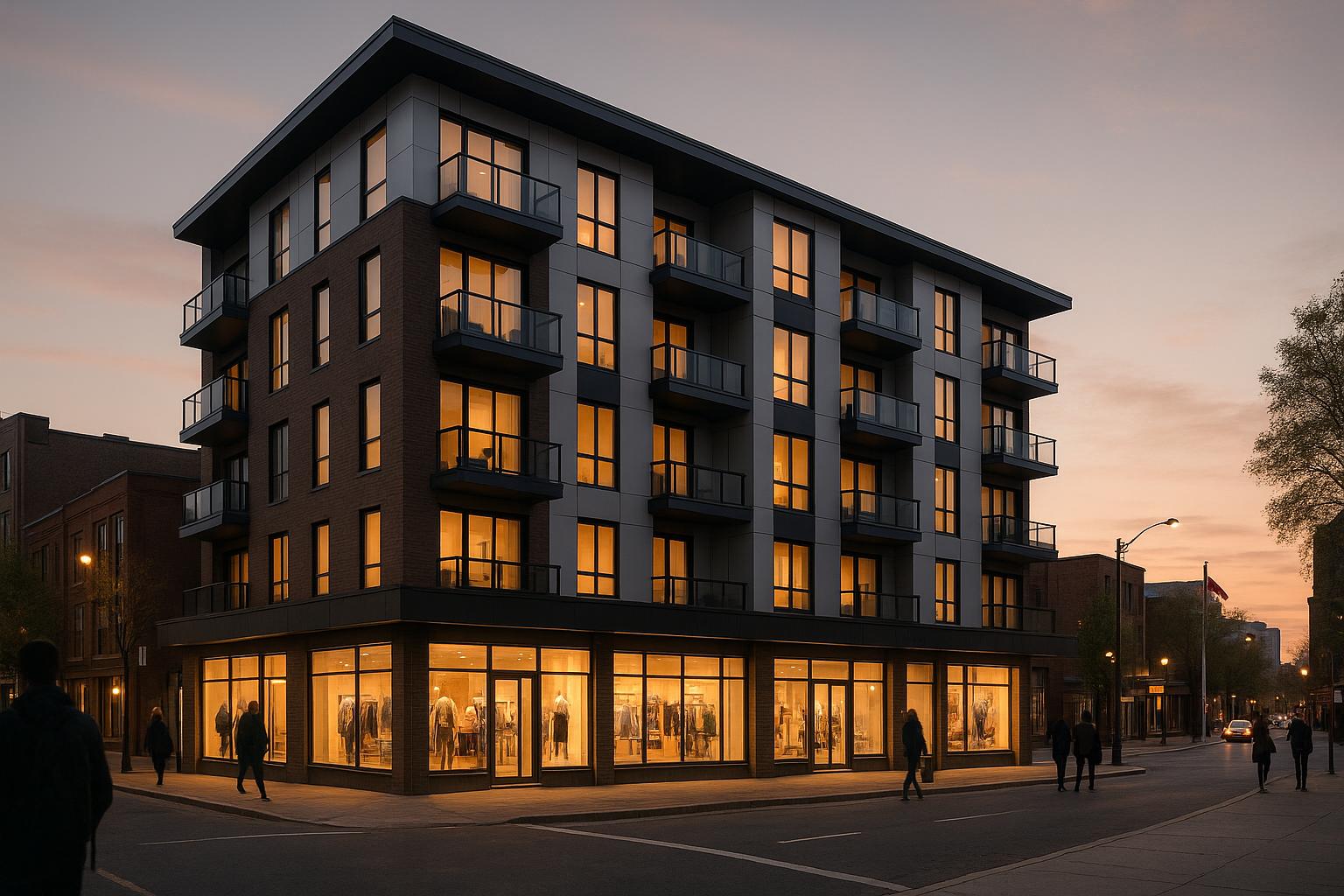When it comes to multi-unit rental developments, Dartmouth offers a more affordable and promising alternative to Halifax. Here's why:
- Lower Costs: Land prices in Dartmouth are significantly cheaper than in Halifax, reducing upfront investment.
- High Rental Demand: Two-bedroom units in Dartmouth typically rent for $1,950–$2,100 per month, with an annual ROI of 12–20%.
- Convenient Location: Easy access to Halifax via ferries and bridges makes Dartmouth attractive to renters.
- Energy Efficiency Savings: Programs like Efficiency Nova Scotia offer rebates - recently, one project saved nearly $49,000 on energy upgrades.
- Construction Advantages: Fixed-price contracts and integrated design-build teams minimize delays, cost overruns, and coordination headaches.
While challenges like harsh harbour weather and zoning regulations exist, careful planning and professional expertise can help you navigate them effectively. By focusing on smart design, energy-efficient systems, and flexible rental strategies, you can maximize returns and ensure long-term success in Dartmouth's rental market.
Dartmouth's Rental Market Data and Trends
Rental Demand and Pricing Compared to Halifax
Dartmouth’s rental market strikes a great balance between affordability and quality. For instance, well-designed two-bedroom units are available at rates that remain competitive, offering tenants access to appealing living spaces while allowing property owners to achieve solid revenue.
With convenient transit options, including ferry and bridge connections, commuting to Halifax's downtown is straightforward, adding to Dartmouth's overall appeal. This pricing advantage attracts a wide range of tenants, making the area an attractive option for both renters and landlords.
Who Rents in Dartmouth
Although detailed demographic data is limited, Dartmouth’s rental market clearly caters to a diverse group of tenants. This diversity makes it essential to design units that can adapt to various needs. For example, two-bedroom layouts can be tailored to serve as living spaces with a home office or as accommodations for families or guests. The flexibility in unit design is key to meeting tenant preferences and maximizing occupancy, further enhancing the market's appeal.
Vacancy Rates and Expected Returns
Dartmouth’s market conditions offer promising opportunities for property owners. Fixed-price construction methods reduce cost uncertainties, ensuring predictable timelines and budgets - both critical for maintaining expected returns.
Additionally, incorporating energy-efficient features can significantly lower operating expenses. Investments in heat pumps, triple-pane windows, and improved insulation not only cut utility costs but also make properties more attractive to tenants who value lower energy bills. Many renters are even willing to pay higher rents for these benefits, further boosting profitability.
These combined factors make Dartmouth a compelling location for property owners aiming to develop and profit from multi-unit rental properties. The region’s balanced market dynamics, coupled with cost efficiencies, create an environment ripe for success.
These Halifax NEIGHBOURHOODS Are About To BOOM (Here's Why)
Construction Requirements for Multi-Unit Properties
When building multi-unit rental properties in Dartmouth, careful planning and early attention to regulatory and site-specific challenges are essential. Addressing these factors upfront can help avoid costly delays and unexpected expenses.
Zoning and Site Considerations
Your project must meet local zoning regulations for multi-unit properties. Collaborating with professionals familiar with Dartmouth’s zoning rules can simplify approvals and help you navigate the best options for your site. Alongside zoning, physical site conditions often require tailored solutions to ensure a smooth construction process.
Building Near the Harbour: Weather and Site Challenges
Constructing near the harbour brings unique challenges, especially with Dartmouth’s coastal weather. Choosing materials and designs that can withstand harsh maritime conditions is crucial. Proper drainage systems and a well-designed foundation are equally important to ensure the building’s durability over time. Addressing these specific risks early on will set the stage for a more efficient construction process.
Single-Team vs. Multiple-Contractor Construction
Managing multiple contractors can lead to miscommunication and project delays. In contrast, using an integrated design-build team combines planning, design, and construction into one streamlined process. This approach often reduces project timelines, with completion in as little as 6 months compared to the 12–18 months typically seen with traditional methods[1]. By simplifying scheduling and improving overall accountability, an integrated team provides a more reliable and efficient path to completing your property.
sbb-itb-16b8a48
How to Maximize Returns on Your Investment
Thoughtful design and strategic planning can strike the perfect balance between upfront costs and long-term revenue, enhancing both rental income and property value. Let’s explore how unit design, finishes, and rental strategies can help you get the most out of your investment.
Choosing Unit Sizes and Layouts
The design of your units goes beyond meeting zoning requirements - it plays a key role in boosting your ROI. Two-bedroom units tend to deliver solid returns, appealing to a wide audience, including young professionals, small families, and roommates. These tenants often stay longer, reducing turnover costs. To maximize appeal, consider an open-concept living and kitchen area, which creates a sense of spaciousness. Adding a workspace or den is especially valuable for remote workers. Don’t forget practical touches like walk-in closets for extra storage. For ground-floor units, even a small patio or deck can make a big difference, offering tenants private outdoor space - a feature many will appreciate.
Energy Systems and Finishes That Increase Rent
Energy-efficient systems and high-quality finishes can significantly enhance a property’s rental appeal. Installing ductless heat pumps allows tenants to control their heating and cooling, giving them predictable utility costs. Triple-pane windows are another smart addition - they improve energy efficiency and reduce outside noise, which is especially useful in a harbour-facing setting.
When it comes to finishes, modern and durable choices matter. Quartz countertops, for instance, convey quality and require less maintenance compared to materials that need regular upkeep. Energy Star appliances not only lower utility bills for tenants but also position your property as a premium offering. For flooring, engineered hardwood in living areas creates a polished, cohesive look while lasting longer than carpet, making it a practical and attractive choice.
Short-Term vs Long-Term Rental Income
Each rental strategy has its pros and cons. Long-term leases provide steady cash flow and reduce turnover, offering a more predictable income stream. On the other hand, short-term rentals can be particularly lucrative for units with harbour views or those near downtown Dartmouth, where visitors are often willing to pay a premium for location and convenience. However, keep in mind that short-term rentals in the Halifax Regional Municipality come with evolving regulations, which can complicate compliance.
A hybrid approach might be the best of both worlds. Start with long-term leases to establish stable income, and as the market evolves, consider converting select units to short-term rentals. This strategy allows you to adapt based on demand while maintaining a reliable foundation of cash flow.
In Dartmouth, long-term rentals can yield an annual ROI of 12–20%, showcasing how careful design and strategic planning can lead to strong returns with less day-to-day involvement.
Avoiding Common Construction Problems
Multi-unit construction projects can become chaotic without proper risk management. Traditional methods often lead to blown budgets and missed deadlines. Recognizing these challenges and putting effective measures in place can save you both time and money. This is why taking a well-coordinated approach is essential for successful multi-unit builds in Dartmouth.
Preventing Cost Overruns and Schedule Delays
A major cause of construction issues is poor communication among contractors. When your architect, engineer, plumber, electrician, and general contractor operate independently, you often end up acting as the project manager - juggling unexpected problems along the way.
Cost overruns frequently arise when conflicts between trades are discovered mid-project. For instance, an HVAC contractor might find that the electrical plans interfere with the ductwork layout. Fixing such conflicts often requires redesigns and rework, driving up costs significantly.
Opting for fixed-price contracts with integrated teams can reduce these risks. Unlike cost-plus contracts, where every delay or change increases your expenses, fixed-price agreements lock in the total cost before construction starts. Integrated teams - where design, engineering, and construction professionals collaborate from the beginning - further minimize errors. This approach eliminates the blame game, saving property owners an average of $47,000 in coordination waste on a standard fourplex project.
Daily Updates and Quality Control
Maintaining transparency during construction helps catch potential issues early and ensures quality standards are met. Daily photo updates allow you to monitor progress remotely, while detailed reports on work completed and materials delivered keep everyone accountable.
Real-time tracking prevents disputes and keeps schedules on track. Additionally, third-party inspections provide an extra layer of assurance. Having a Professional Engineer (P.Eng) inspect your project at critical stages - such as after the foundation, framing, mechanical rough-in, insulation, and final phases - ensures the work meets high standards. Choosing your own final inspector gives you peace of mind that the job is done right.
Quality control measures should also include warranties. A builder offering a two-year warranty on construction signals confidence in their work and provides you with a safety net in case issues arise after completion. These steps complement the integrated approach, creating a smoother process from start to finish.
Construction Financing and Contract Terms
Securing construction financing is different from obtaining a traditional mortgage and requires careful planning to avoid cash flow issues. Most construction loans involve interest-only payments during the build phase, with funds released in stages as milestones are completed.
Programs like the CMHC MLI Select offer appealing options for financing energy-efficient multi-unit properties in Dartmouth. With up to 95% financing, a 5% down payment, and 50-year amortization periods, this program can significantly ease financial pressures. Properties must be 40% more energy-efficient than current building codes, but the long-term financing benefits often outweigh the additional costs.
To avoid delays, include penalty clauses in your contracts. For example, a one-month delay on a fourplex can cost around $8,800 in lost rental income. Penalties of up to $1,000 per day for missed deadlines can motivate your construction team to stay on schedule.
Clear contract terms are equally important. Define the scope of work, material specifications, and procedures for handling changes in detail. Vague contracts often lead to disputes and unexpected costs. Tie payments to milestones to ensure work is completed to your satisfaction before releasing funds. This keeps the project on track and protects your investment.
Why Dartmouth Works for Multi-Unit Rental Properties
Dartmouth stands out as a smart choice for multi-unit rental properties, thanks to its mix of lower costs and prime location. With affordable land prices, a high demand for rentals, and its harbour-side setting, the area offers property owners the chance to see strong returns and steady cash flow right from the start. For example, standard construction costs in Dartmouth are kept efficient, with a fixed-price rate of $160,000 per unit, helping investors maximize their profits.
The waterfront location adds another layer of potential. Properties near the harbour can command higher rents, thanks to the appeal of water views and the area's reputation as a less crowded alternative to busier urban centres. These factors make Dartmouth especially attractive to tenants looking for both convenience and quality of life.
However, Dartmouth's unique environment does require a thoughtful construction process. Traditional methods can lead to coordination issues, budget overruns, and delays, all of which can quickly eat into profits. Factors like unpredictable weather, specific soil conditions, and local municipal regulations make seamless collaboration between design and construction teams a must. Fixed-price contracts with guaranteed timelines are particularly valuable here, as they shield investors from costly delays. For instance, on a standard fourplex, a one-month delay could mean losing around $8,800 in rental income.
Property owners who try to juggle multiple contractors on their own often face higher costs due to miscommunication and inefficiencies. By choosing an integrated approach - where design and construction are managed under one roof - investors can ensure smoother projects and more reliable returns in Dartmouth's rental market.
FAQs
Why is Dartmouth a smart choice for building multi-unit rental properties compared to Halifax?
Dartmouth is a standout choice for those looking to invest in multi-unit rental properties without breaking the bank. Compared to Halifax, land and property prices are more budget-friendly, allowing investors to enjoy better returns on investment. Plus, the area’s growing rental demand adds to its appeal. Being close to Halifax means renters can easily access urban amenities while enjoying more affordable housing options.
On top of that, Dartmouth often has fewer regulatory challenges and more flexible zoning rules. This can simplify the construction process and help keep costs down. As the area becomes increasingly popular among renters and buyers, it offers property owners a promising chance to boost profitability while catering to a rising market demand.
What should property owners know about managing construction challenges near Dartmouth's harbour?
Building in the Dartmouth harbour area comes with its own set of challenges. The region's high winds, constant moisture, and exposure to salt can take a toll on structural integrity and the lifespan of materials. That’s why it’s crucial to start with a detailed site assessment. By understanding the specific conditions, you can make informed decisions about materials and design that will stand up to the environment.
Collaboration with local authorities is equally important. This ensures your project aligns with zoning and waterfront regulations, helping you steer clear of delays or legal complications. On top of that, using environmentally conscious methods - like controlling erosion and carefully handling infill materials - not only safeguards the delicate harbour ecosystem but also builds goodwill within the community.
What are the best strategies to increase rental income and keep units occupied in Dartmouth's rental market?
To increase rental income and keep occupancy rates high in Dartmouth, prioritize offering properties that are in great condition and include amenities that tenants find appealing. Regularly reviewing local market trends will help you set competitive rental rates, while effective advertising and a focus on tenant retention can keep vacancy periods to a minimum.
Recent zoning changes allowing for 4-8 unit buildings present a great opportunity to grow your rental portfolio and boost income potential. Additionally, properties designed with efficient layouts and energy-saving features not only attract tenants but also help lower operating costs, improving your overall returns.



